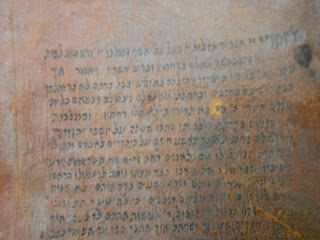Care for old Megillat Esther
I am hoping if you guys can confirm the origin of this megillah. I recently acquired an old "North African 19th century" Megillah.
It's written with 19 lines on gevil with setumot according to Rambam. (I believe)
At a cursory glance there are a number of letters that are rubbed out, some old patches, worm holes, and discoloration of the gevil. At the very beginning there is a prayer (I think) written in Rashi script with a tear through it at the edge.
The 10 sons of Haman is written similar to Chabad.
It doesn't look like it was mounted on an etz, unless it was glued on, and it seems to be folded between each column.
I would like to, at least, reinforce the edges where the gevil is starting to tear or has torn. What's the best way to do this? Glue strips of klaf on the tears?
What are some precautions I should take in caring for this megillah?
Thanks in advance
It's written with 19 lines on gevil with setumot according to Rambam. (I believe)
At a cursory glance there are a number of letters that are rubbed out, some old patches, worm holes, and discoloration of the gevil. At the very beginning there is a prayer (I think) written in Rashi script with a tear through it at the edge.
The 10 sons of Haman is written similar to Chabad.
It doesn't look like it was mounted on an etz, unless it was glued on, and it seems to be folded between each column.
I would like to, at least, reinforce the edges where the gevil is starting to tear or has torn. What's the best way to do this? Glue strips of klaf on the tears?
What are some precautions I should take in caring for this megillah?
Thanks in advance
 |
| First Column with prayer |
 |
| Tear at first column |
 |
| Column 1 of Megillat Esther |
 |
| Discoloration, letters rubbed out, and worm damage |
 |
| Discoloration and worm hole |
 |
| Patch |
 |
| 10 sons of Haman |

It certainly looks old and Sephardi. For what it's worth, I know someone who has a 16th century North African megillah, so I'll describe what I recall of it.
ReplyDeleteHis megillah is on an eitz and has an extra length of g'vil at the end for protecting the text itself, which is also on g'vil. The k'tav is similar, although I'd need it in front of me to say any more on the that. 10 b'nei Haman are written large in their own amud, although the amudim are relatively small (although not 11 lines).
כל טוב